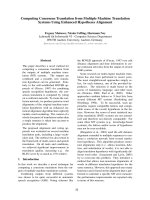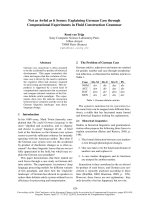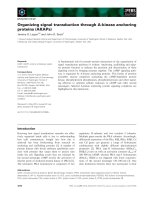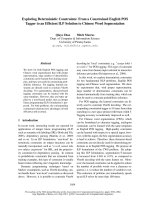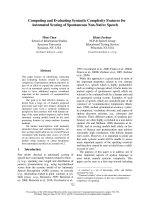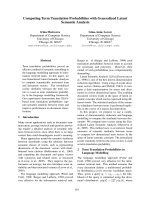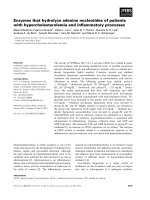báo cáo khoa học: "Computing genetic evaluations through application of generalized least squares to an animal model" pot
Bạn đang xem bản rút gọn của tài liệu. Xem và tải ngay bản đầy đủ của tài liệu tại đây (484.44 KB, 10 trang )
Computing
genetic
evaluations
through
application
of
generalized
least
squares
to
an
animal
model
G.F.S. HUDSON
Department
of
Animal
Sciences,
University
of
Maryland,
College
Park,
Maryland
20742,
U.S.A.
Summary
The
animal
model
for
performance
data
is
rewritten
in
the
form
of
a
fixed
model
with
uncorrelated
residuals.
This
transformation
allows
the
use
of
computationally
efficient
methods
for
solving
generalized
least
squares
problems
to
obtain
best
linear
unbiased
predictions
of
breeding
values.
Application
of
a
specific
algorithm
to
the
transformed
model
is
described
and
compared
with
more
traditional
approach
of
obtaining
solutions
to
the
mixed
model
equations
through
an
iterative
process.
The
new
approach
may
have
merit
for
recursive
prediction
of
breeding
values
from
sequentially
collected
data.
Key
words :
Animal
model,
QR
algorithm,
best
linear
unbiased
prediction.
Résumé
Calcul
des
valeurs
génétiques
par
application
des
moindres
carrés
généralisés
à
un
modèle
animal
Le
modèle
statistique
d’interprétation
des
données
de
contrôle
de
performances
est
réécrit
sous
la
forme
d’un
modèle
à
effets
fixés,
avec
des
résidus
non
corrélés.
Cette
transformation
permet
d’utiliser
des
méthodes
de
résolution
des
problèmes
de
moindres
carrés
généralisés,
efficaces
sur
le
plan
calculatoire,
pour
obtenir
les
meilleures’
prédictions
linéaires
sans
biais
des
valeurs
génétiques.
L’application
d’un
algorithme
spécifique
au
modèle
transformé
est
décrite
et
comparée
à
l’approche
plus
classique
d’obtention
de
solutions
aux
équations
du
modèle
mixte
par
un
processus
itératif.
L’approche
proposée
peut
présenter
un
intérêt
pour
une
prédiction
récursive
des
valeurs
génétiques
à
partir
de
données
recueillies
de
façon
séquentielle.
Mots
clés :
Modèle
animal,
algorithme
QR,
meilleure
prédiction
linéaire
sans
biais.
I.
Introduction
Initial
research
into
the
use
of
mixed
model
equations
to
obtain
best
linear
unbiased
predictions
of
breeding
values
or
transmitting
abilities
concentrated
on
application
of
separate
sire
and
cow
models
to
dairy
cattle
data,
based
on
the
pioneering
work
of
C.R.
Henderson
at
Cornell
University
(see
T
HOMPSON
,
1979
for
a
review).
In
1976,
H
ENDERSON
&
Q
UAAS
described
an
animal
model
for
simultaneous
evaluation
of
males
and
females
based
on
available
performance
data
from
both
evaluated
and
related
animals.
The
animal
model
has
advantages
over
the
separate
sire
and
cow
models :
-
for
non
sex-limited
traits
the
sire’s
own
performance
record
is
used
which
is
equivalent
in
reliability
to
many
half-sib
progeny
records
for
traits
with
high
heritabi-
lity ;
-
all
relationships
can
be
used,
completely
accounting
for
selection
among
dams ;
-
nonrandom
mating
of
bulls
causes
no
bias
in
the
evaluations ;
-
evaluation
of
females
is
improved
(compared
with
a
within-herd
cow
model)
by
incorporation
of
across
herd
relationships
and
by
direct
incorporation
of
sires’
evalua-
tion
rather
than
an
approximation.
A
major
disadvantage
of
the
animal
model
is
the
commonly
large
number
of
equations
to
be
solved.
For
example,
implementing
the
animal
model
for
dairy
cattle
evaluation
in
the
northeastern
U.S.
involved
over
1,500,000
animal
equations
and
nearly
one
quarter
million
fixed
effect
equations
(W
ESTELL
,
1984).
Attempts
have
been
made
to
reduce
the
computational
effort
involved
in
using
the
animal
model.
A
major
contribution
was
made
by
Q
UAAS
&
P
OLLAK
(1980)
who
used
a
gametic
model
for
records
of
animals
without
progeny,
thus
the
only
equations
needed
were
those
of
parent
and
ancestor
animals.
A
practical
application
of
this
«
reduced
animal
model
»
to
swine
evaluation
by
H
UDSON
&
KE
rrNEnv
(1985)
required
only
10
to
20
p.
100
of
the
animal
equations
needed
by
the
full
animal
model.
Recursive
prediction
allows
further
reduction
of
the
number
of
equations
to
be
solved
by
evaluating
only
animals
of
interest.
For
example,
dead
animals
need
not
be
directly
evaluated
although
information
from
these
animals
is
retained
(H
UDSON
,
1984).
Recursive
prediction
techniques
require
the
variance-covariance
matrix
of
estimates
and
prediction
errors,
and
therefore
preclude
the
use
of
iterative
methods
to
obtain
solutions.
This
paper
describes
a
procedure
for
representing
the
animal
model
as
a
fixed
model.
Advanced
computational
methods
for
solving
generalized
least
squares
problems
can
then
be
applied
to
obtain
the
necessary
variances
and
covariances
for
recursive
prediction.
II.
The
animal
model
The
animal
model
is
demonstrated
here
for
a
simple
situation :
-
each
animal
has
a
single
record
on
one
trait ;
-
each
animal
with
a
record
has
both
sire
and
dam
identified ;
-
some
ancestors
with
recorded
progeny,
but
without
performance
records
of
their
own,
do
not
have
identified
sire
or
dam
and
are
a
random
sample
from
a
base
population ;
-
the
only
fixed
effect
is
the
mean
of
records
observed
in
a
particular
period
(years,
seasons,
etc.) ;
-
animals
may
be
inbred
and
the
model
allows
overlapping
generations.
Relaxation
of
these
assumptions
will
be
indicated
where
appropriate.
The
n
x
1
vector
of
data,
yi,
observed
in
the
it’
period
is
described
by
the
equation
where
ii
is
a
vector
of
ni
ones,
Ki
is
the
mean
of
y,
ai
is
the
vector
of
additive
genetic
effects
(breeding
values)
of
animals
with
records
in
y,,
random
with
mean
zero
and
variance
Al
a;,
and
ei
is
the
vector
of
residuals,
random
with
mean
zero
and
variance
Iu’.
The
breeding
value
of
the
k’&dquo;
animal
in
a,
can
be
represented
as
where
a!
and
af
are
breeding
values
of
the
sire
and
dam
of
the
k’&dquo;
animal,
and
Vk
represents
Mendelian
sampling
and
is
defined
as
the
deviation
of
ak
from
.5
(ak
+
ak),
the
mid-parent
value.
Equation
(2)
is
the
gametic
model
of
Q
UAAS
&
P
OLLAK
(1980).
If
all
the
parents
of
animals
represented
in
a;
are
in
a,_,
then
the
vector
representation
of
(2)
is
where
T; ;
_,
is
an
n,
x
n
i-I
matrix
relating
offspring
in
a;
to
parents
in
a;
_,.
The
k’
h
row
of
Ti,
i-
,
has
.5
in
columns
corresponding
to
the
parents
of
the
k’&dquo;
animal
in
ai,
and
zeros
elsewhere.
For
overlapping
generations,
equation
(3)
is
written
as
For
i
>
0,
var
v;
=
Di
a.’ :
D;
is
a
diagonal
matrix
with
the
k’&dquo;
diagonal
equal
to
.5 -
.25
(F,
+
Fd
),
F,
and
Fd
are
Wright’s
coefficients
of
inbreeding
for
the
sire
and
dam
of
the
k’&dquo;
animal,
and
Qa
is
the
additive
genetic
variance
in
the
base
population.
For
i
=
0,
ao
is
the
vector
of
breeding
values
of
ancestors
from
the
base
population.
If
these
animals
are
a
random
sample,
define
ao
=
v,
with
var
V
&dquo;
=
JU
2 .
The
recursive
equation
(4)
can
be
succinctly
written
for
all
animals
as
where
a
=
(a
;
),
v
=
(v
;)
for
i
=
0,
1, ,
N,
and
T
is
a
block
matrix
with
subdiagonal
blocks
equal
to
T
;.
j
of
(4),
and
null
blocks
on
and
above
the
diagonal.
For
example,
for
3
periods
of data
(5)
is
Rearrangement
of
(5)
leads
to
Thus
(H
ENDERSON
,
1976 ;
Q
UAAS
,
1976 ;
T
HOMPSON
,
1977)
and
(H
ENDERSON
,
1976 ;
Q
UAAS
,
1976)
In
(7)
and
(8),
D
is
block
diagonal
matrix
of
D;,
superscript
t
indicates
matrix
transpose,
and
superscript —
t
indicates
transposition
of
the
inverse
matrix.
The
model
for
all
data
from
N
periods
is
where
y
=
(y
i
),
X
=
2!1., ! =
(w;),
a.
=
(a
i
),
and
e
=
(e
i)
with
i
=
1, 2,
,
N and Y.’
indicating
direct
matrix
summation.
The
complete
data
equation
(9)
can
be
combined
with
the
animal
equation
by
writing
(5)
as
then
(9)
and
(10)
together
are
with
0
and
0
being
null
vectors
and
matrices
of
appropriate
order.
D
UNCAN
&
HORN
(1972)
describe
(11)
as
a
linear
dynamic
recursive
model
which
forms
the
basis
of
recursive
prediction
(H
UDSON
,
1984).
Equations
similar
to
(11)
have
been
described
for
a
general
(i.e.,
with
T
null)
mixed
model
by
D
EMPSTER
et
al.
(1981,
1984)
and
for
a
sire
model
by
FRIES
(1984).
Similar
equations
also
have
been
presented
for
fixed
models
in
terms
of
ridge
regression
(M
ARQUARDT
,
1970)
and
for
variable
selection
in
multiple
regression
problems
(A
LLEN
,
1974).
For
data
from
three
periods
equations
(11)
have
seven
«
rows
»
Other
models
familiar
to
animal
breeders
can
be
derived
from
(11).
Animals
represented
in
a,
are
nonparents,
i.e.,
they
have
their
own
performance
records
but
no
progeny
data.
If
row
7
of
the
example
is
subtracted
from
row
3,
the
latter
becomes
(thus
eliminating
a3)
and
the
model
becomes
the
reduced
animal
model
of
QuAAs
and
P
OLLAK
(1980).
If
y;
contains
only
daughter
records
and
ai
contains
only
male
breeding
values,
then
suitable
redefinition
of
ei,
T,,
and
D;
generates
either
the
sire
model
or
the
maternal
grandsire
model
of
Q
UAAS
et
al.
(1979).
Fixed
effects
other
than
the
period
mean
can
be
incorporated
by
replacing
ii
i
with
a
vector
P,
and
replacing
li
with
appropriately
defined
incidence
(or
regressor)
matrices.
Fixed
effects
may
fall
into
two
categories
(H
UDSON
,
1984) :
those
common
to
all
data
(e.g.,
sex,
age,
P)
and
those
specific
to
data
collected
in
the
i’&dquo;
period
(e.g.
year-season
means,
Di
).
To
avoid
rank
deficiency
problems
in
X,
fixed
effects
should
be
defined
so
that 13
and
all
!3;
are
jointly
estimable.
If
no
pedigree
information
is
missing,
the
T
¡.
j
completely
account
for
selection
and
no
genetic
groups
are
required
in
the
model.
The
utility
of
(11)
is
demonstrated
by
treating
a
as
fixed
and
setting
up
the
generalized
least
squares
normal
equations
with
a
=
oz
/oe
and
&dquo; indicating
solution,
not
parameter.
Equations
(12)
are
identical
to
the
mixed
model
equations
for
(9),
therefore
p
and
A
are
the
best
linear
unbiased
estimator
and
predictor
of
p.
and
a.
See
D
EMPSTER
et
al.
(1981)
for
a
Bayesian
derivation
of
(11)
and
(12)
from
a
general
mixed
model.
Thus
equations
(11)
represent
a
method
by
which
an
animal
model
for
multiperiod
data
can
be
written
in
terms
of
a
fixed
model
with
heterogeneous
variances.
There
are
numerous
computing
algorithms
for
least
squares
problems
applied
to
fixed
linear
models,
and
some
may
provide
means
by
which
animal
breeders
can
easily
process
periodic
data
through
the
use
of
(11).
III.
The
QR
algorithm
for
generalized
least
squares
A.
General
principles
The
QR
algorithm
(S
TEWART
,
1973 ;
L
AWSON
&
H
ANSON
,
1974 ;
V
AN
LOAN,
1976)
for
solving
generalized
least
squares
problems
is
described
here
for
the
fixed
linear
model
with
X
having
full
column
rank,
q,
and
E
=
CC’.
Define
C
as
the
lower
triangular
decomposition
of
E.
If
E
is
diagonal
(as
is
the
variance-covariance
matrix
of
the
residuals
in
(11)),
then
C
is
also
diagonal.
Define
X
and
y as
solutions
to
C
[X
ý] =
[X
y]
and
write
the
model
for
y as
Thus
a
standardization
of
variables
has
transformed
the
model
to
one
with
uncorrelated
residuals
with
unit
variances.
Now
define
Q
such
that
1)
Q
is
orthogonal
(i.e.,
Qt
Q
=
I),
4)
R
is
an
upper
triangular
matrix
with
order
and
rank
equal
to
the
rank
of
X,
q.
The
generalized
least
squares
solution
to
(13)
is
the
solution
to
or, equivalently,
or,
equivalently,
That
b
is
the
generalized
least
squares
solution
to
(13)
is
demonstrated
by
premultiplying
(15)
by
X’Q’
which
yields
the
familiar
normal
equations.
Solving
equa-
tions
(17)
is
trivial
because
R
is,
by
definition,
upper
triangular.
Less
easy
is
determi-
ning
Q,
which
is
the
product
of
a
series
of
q
orthogonal
matrices
Q,,
Qq!l’
Q,
with
Q,
defined
so
that,
for
ie,
being
the
i’
h
column
of
Q;
_,Q
;_2
Q,X,
Qiki
is
a
vector
with
zeros
in
all
elements
below
the
i’&dquo;
element,
thus
satisfying
the
second
and
fourth
conditions
above.
Each
Qi
is
a
Householder
reflection
matrix
described
next.
B.
Householder
matrices
For
any
vector
w
the
corresponding
Householder
matrix
is
H
=
I —
2uu’/u’u
where
u
=
w
with
the
first
element
replaced
by
w,
+
8
(W’W
)’
5
;
8
=
1
if
w, !
0
and
8
= -
1
if
w,
<
0.
Thus
Hw
=
[8
(w’w)
5,
0,
0,
0]‘,
i.e.,
the
Householder
matrix
has
«
zeroed-
out
» all
but
the
first
element
of
Hw.
Straightforward
multiplication
shows
that
H
is
orthogonal.
To
zero-out
elements
below
the
diagonal
in
ie
&dquo;
define
w,
as
(x, ,
i :Ri+ 1,
X-
!,
Y
and
then
’
Note
that
to
apply
the
OR
algorithm
the
matrix
Q
in
(15)
need
not
be
explicitly
created
or
stored.
Householder
reflections
are
applied
directly
to
X
and
y.
For
example,
to
apply
the
Householder
reflection
H
=
I -
2uu’
/
u’u
to
a
vector
z
(either
a
column
of
X
or
y)
simply
requires
subtracting
from
z a
scalar
multiple
of
u
(Gou
LT
et
al. ,
1974) :
Hz
=
z —
(2u’z/u’u)u.
In
situations
that
requires
retaining
Q
for
future
use,
then
nonzero
elements
of
u
can
occupy
the
zeroed-out
elements
of
w
(Lnwsorr
&
H
ANSON
,
1974).
The
coefficient
matrix
of
(11)
is
both
sparse
and
highly
structured ;
the
design
of
the
QR
algorithm
can
utilize
both
properties.
For
example,
the
Householder
matrix
can
be
constructed
to
operate
on
only
nonzero
elements.
Appropriate
reordering
of
rows
of
[X
y] can
exploit
the
structure
of
the
equations.
C.
Updating
the
QR
with
new
data
Data
are
often
collected
sequentially
over
an
extended
period
of
time.
New
data
are
combined
with
old
data
to
provide
updated
solutions ;
with
the
QR
algorithm
this
updating
procedure
is
relatively
easy.
Suppose
the
OR
algorithm
has
been
applied
to
the
data
and
incidence
matrix
of
the
transformed
model
(14)
so
that
R and
y,
of
(17)
exist.
New
data,
y,,
are
collected
which
fit
the
model
with
cov
(e,
ez)
=
0.
Model
(18)
is
transformed
to
and
the
QR
algorithm
is
applied
to
Householder
reflections
are
applied
to
(20)
so
that
X2
is
zeroed-out.
Note
that
Q
of
(15)
is
not
required
for
the
updating
procedure.
The
updating
described
here
should
not
be
confused
with
recursive
prediction
by
which
new
solutions
are
obtained
from
new
data
along
with
previous
solutions
and
their
variances
(H
UDSON
,
1984).
This
updating
procedure
simply
combines
the
new
data
with
the
old
equations
and
applies
the
QR
algorithm.
D.
Variance-covariance
matrix
of
solutions
The
variance-covariance
matrix
of
b
is
required
to
generate
confidence
intervals
and
to
test
hypotheses
about
b,
and
is
also
required
in
recursive
estimation
and
prediction
(HuDSOrr,
1984).
Obtaining
li
by
solving
(17)
does
not
requires
R-
I
because
R
is
triangular.
However
var
b
=
R-
I
R-’(T
2.
Thus
the
inverse
may
be
required
in
certain
applications.
Inverting
a
triangular
matrix
is
straightforward,
but,
in
certain
cases,
var
b
itself
is
not
needed.
For
example,
to
test
the
hypothesis
K’b
=
m
requires
var
K’b
=
K’
var
b
K
=
K’ii-’it-’K.
L
AWSON
&
H
ANSON
(1974)
suggest
computing
this
as
AA’
where
A
is
solution
to
AR
=
K’.
Diagonal
elements
of
ii-
l
ii-
t
are
needed
for
confidence
intervals
and
are
calculated
by
the
sum
of
squares
of
elements
in
each
row
of
R ’
IV.
Comparing
the
QR
algorithm
with
normal
equations
Criteria
by
which
computer
algorithms
are
often
compared
include
central
proces-
sing
unit
time
required
for
various
parts
of
the
process,
amount
of
storage
needed and
accuracy
of
final
solutions.
If
X
is
square,
then
the
QR
algorithm
requires
two-thirds
the
storage
locations
of
the
normal
equations
method
(L
AWSON
&
H
ANSON
,
1974).
As
the
number
of
rows
of
X
increases
relative
to
the
number
of
columns
the
advantage
of
the
QR
over
normal
equations
decreases.
For
example,
if
there
are
5
times
as
many
rows
as
columns
in
X,
then
the
QR
requires
as
much
as
90
p.
100
of
the
storage
locations
needed
by
the
normal
equations.
If
the
ratio
of
number
of
rows
to
number
of
columns
exceeds
50,
then
storage
requirements
of
each
method
are
essentially
equal.
L
AWSON
&
H
ANSON
(1974)
discuss
in
detail
the
accuracy
of the
QR
algorithm
and
compare
various
methods.
In
general,
to
obtain
solutions
of
comparable
accuracy,
the
normal
equations
must
be
computed
with
higher
precision
arithmetic
than
the
QR
algorithm.
This
is
only
of
concern
to
animal
breeders
if
the
linear
model
contains
covariates,
and
even
then
careful
avoidance
of
collinearity
and
scaling
of
variables
can
lessen
problems
due
to
loss
of
accuracy.
If
X
is
an
incidence
matrix
with
no
regressors
each
method
produce
solutions
of
equal
accuracy.
Ranking
animals
for
the
purpose
of
making
selection
decisions
certainly
does
not
require
solutions
to
machine
accuracy.
The
major
criterion
for
comparing
the
QR
algorithm
with
normal
equations
is
computer
time.
If
X
is
square
and
has
no
special
exploitable
structure
then
the
QR
method
requires
the
same
number
of
computer
operations
as
setting
up
and
solving
the
normal
equations.
If,
as
is
usual,
the
number
of
rows
in
X
exceeds
the
number
of
columns
then
the
normal
equations
method
is
approximately
twice
as
fast
as
the
QR
method.
If
X
is
an
incidence
matrix
with
no
regressor
variables
then
further
time
savings
are
available
because
generating
the
normal
equations
requires
only
summation
operations
and
no
multiplications.
Applying
the
QR
algorithm
to
incidence
matrices
also
reduces
the
computational
work
compared
with
the
general
case.
For
example,
triangularizing
X
in
(11)
is
rapid
due
to
the
simple
structure
of
X.
Additional
time
can
be
saved
by
applying
normal
equations
to
(11)
because
(I —
T)
I
D-
1
(I —
T)
of
(12)
can
be
generated
directly
by
the
methods
of
H
ENDERSON
(1976)
and
Q
UAAS
(1976),
which
requires
less
work
than
zeroing-out
(I —
T)
in
(11).
The
actual
time
requirements
of
applying
QR
to
(11)
have
yet
to
be
determined.
Animal
breeders
do
not
require
solutions
of
great
accuracy
and
often
use
iterative
methods
such
as
successive
overrelaxation
(GouLT
et
al.,
1974)
to
solve
(12).
This
approach
has
been
investigated
by
numerous
authors,
but
B
LAIR
&
P
OLLAK
(1984)
conclude :
«
Sufficiently
accurate
ranking
of
animals
for
selection
purposes
is
achieved
long
before
random
effect
solutions
converge,
especially
if
the
[reduced
animal
model
of
Q
UAAS
&
P
OLLAK
(1980)]
is
used
».
Even
their
criterion
for
convergence,
the
mixed
model
equivalent
of
c
=
(ê’X’Xê/y’X’Xy)’5
<
.0001,
(e
is
the
estimated
residual
vector)
did
not
involve
solutions
accurate
to
machine
precision.
V
AN
V
LECK
&
E
DLIN
(1984)
evaluated
484
Holstein
bulls
for
calving
difficulty
of
their
calves :
4
iterations
produced
solutions
deemed
sufficiently
accurate
with
c
<
.0005 ;
an
extra
16
iterations
yielded
c
<
.0001.
GouLT
et
al.
(1974)
suggested
that,
for
any
system
of
non-symmetric
non-
sparse
equations :
«
an
iterative
method
may
have
the
advantage
provided
the
number
of
iterations
needed
to
give
the
accuracy
desired
is
less
than
about
[one-third
the
number
of
equations]
».
This
obviously
held
in
the
case
of
V
AN
V
LECK
&
E
DLIN
(1984).
The
advantage
of
iterative
methods
is
even
greater
if
the
equations
are
sparse
and
symmetric,
as
(12)
often
are.
B
LAIR
&
P
OLLAK
(1984)
did
note
that
more
iterations
were
required
to
obtain
an
accurate
indication
of
genetic
trend,
than
to
rank
animals
for
selection.
V.
Discussion
Generation
and
iterative
solving
of
mixed
model
equations
is,
for
a
large
class
of
linear
models
common
in
animal
breeding,
rapid
and
straightforward.
Sufficiently
accurate
solutions
may
be
obtained
after
only
a
few
iterations,
especially
if
the
ranking
of
animals
is
the
only
concern.
If
estimates
of
genetic
trend
are
required,
many
more
iterations
are
needed.
Under
what
conditions,
then,
may
the
QR
algorithm
be
superior
(in
terms
of
computer
usage)
than
the
more
traditional
methods ?
The
answer
relies
on
exploiting
the
triangularity
of
R.
First,
equations
(17)
are
easy
to
solve
and
the
solution
to
any
particular
equation,
the
k’&dquo;
say,
requires
only
solutions
from
k
+
1
to
N.
In
order
to
solve
the
k’
h
equation,
solutions
from
1
to
k —
1
are
not
needed.
Thus
fixed
effect
solutions
are
not
required
to
compute
estimated
breeding
values.
If
equations
are
ordered
as
shown
in
the
example,
then
ancestor
equations
are
not
required
to
obtain
solutions
for
younger
animals.
These
unneeded
equations
may
in
fact
be
discarded
after
they
have
been
triangularized.
Second,
updating
R
with
new
data
is
quite
straightforward.
The
only
equations
that
change
are
those of
parents
and
common
fixed
effects ;
new
equations
are
needed
for
new
fixed
effects
and
new
animals.
Once
the
update
to
R2
has
been
accomplished,
solving
(21)
is
trivial.
Although
updating
mixed
model
equations
is
also
straightforward,
those
updated
equations
then
need
to
be
re-iterated.
Third,
inverting
a
triangular
matrix
is
easy,
thus
obtaining
variances
of
fixed
solutions
and
of
errors
of
prediction
is
also
easy.
This
may
facilitate
the
use
of
recursive
prediction
of
breeding
values
which
is
not
possible
if
solutions
are
obtained
by
iterating
mixed
model
equations.
Acknowledgements
The
research
described
in
this
paper
was
initiated
whilst
the
author
was
a
postdoctoral
research
fellow
in
the
Departement
of
Animal
and
Poultry
Science,
University
of
Guelph.
This
is
Scientific
Article
Number
A-4196,
Contribution
Number
7181
of
the
Maryland
Agricultural
Experiment
Station.
Received
April
10,
1985.
Accepted
July
3,
1985.
References
A
LLEN
D.M.,
1974.
The
relationship
between
variable
selection
and
data
augmentation
and
a
method
for
prediction.
Technometrics,
16,
125-127.
B
LAIR
H.T.,
P
OLLAK
E.J.,
1984.
Comparison
of
an
animal
model
and
an
equivalent
reduced
animal
model
for
computational
efficiency
using
mixed
model
methodology.
J 4nim.
Sci.,
58,
1090-
1096.
D
EMPSTER
A.P.,
R
UBIN
D.B.,
T
SUTAKAWA
R.K.,
1981.
Estimation
in
:,ovariance
components
models.
J.
Am.
Stat.
Assoc.,
76,
341-353.
D
EMPSTER
A.P.,
S
ELWYN
M.R.,
P
ATEL
C.M.,
ROTH
A.J.,
1984.
Statistical
and
computational
aspects
of
mixed
model
analysis.
Appl.
Stat.,
33,
203-214.
D
UNCAN
D.B.,
HORN
S.B.,
1972.
Linear
dynamic
recursive
estimation
from
the
viewpoint
of
regression
analysis.
J.
Am.
Stat.
Assoc.,
67,
815-821.
FRIES
L.A.,
1984.
A
study
of weaning
weights
in
Hereford
cattle
in
the
state
of Rio
Grande
do
Sul,
Brazil,
Ph.D.
Thesis,
Iowa
State
Univ.,
Ames,
Iowa.
G
OULT
R.J.,
H
OSKINS
R.F.,
M
ILNER
J.A.,
P
RATT
M.J.,
1974.
Computational
methods
in
linear
algebra,
204
pp.,
Wiley,
New
York.
H
ENDERSON
C.R.,
1976.
A
simple
method
for
computing
the
inverse
of
a
numerator
relationship
matrix
used
in
prediction
of
breeding
values.
Biometrics,
32,
69-83.
H
ENDERSON
C.R.,
Q
UAAS
R.L.,
1976.
Multiple
trait
evaluation
using
relatives’
records.
J.
Anim.
Sci.,
43,
1188-1197.
H
UDSON
G.F.S.,
1984.
Extension
of
a
reduced
animal
model
to
recursive
prediction
of
breeding
values.
J.
Anim.
Sci.,
59,
1164-1175.
H
UDSON
G.F.S.,
K
ENNEDY
B.W.,
1985.
Genetic
evaluation
of
swine
for
growth
rate
and
backfat
thickness.
J.
Anim.
Sci.,
61,
83-91.
L
AWSON
C.L.,
H
ANSON
R.J.,
1974.
Solving
least
squares
problems,
340
pp.,
Prentice-Hall,
Engle-
wood,
New
Jersey.
M
ARQUARDT
D.W.,
1970.
Generalized
inverses,
ridge
regression,
biased
linear
estimation,
and
nonlinear
estimation.
Technometrics,
12,
519-562.
Q
UAAS
R.L.,
1976.
Computing
the
diagonal
elements
and
inverse
of
a
large
numerator
relationship
matrix.
Biometrics,
32,
949-953.
QuAAs
R.L.,
E
VERETT
R.W.,
McCL!NTOCK
A.C.,
1979.
Maternal
grandsire
model
for
dairy
sire
evaluation.
J.
Dairy
Sci.,
62,
1648-1654.
QuAA
s
R.L.,
P
OLLAK
E.J.,
1980.
Mixed
model
methodology
for
farm
and
ranch
beef
cattle
testing
programs.
J. Anim.
Sci.,
51,
1277-1287.
S
TEWART
G.W.,
1973.
Introduction
to
matrix
computations,
441
pp.,
Academic
Press,
New
York.
T
HOMPSON
R.,
1977.
The
estimation
of
heritability
with
unbiased
data.
II.
Data
available
on
more
than
two
generations.
Biometrics,
33,
497-504.
T
HOMPSON
R.,
1979.
Sire
Evaluation.
Biometrics,
35,
339-353.
V
AN
LOAN
C.F.,
1976.
Lectures
in
least
squares.
Technical
Report
TR
76-279,
Dept.
of
Comp.
Sci.,
Cornell
Univ.,
Ithaca,
New
York.
V
AN
V
LECK
L.D.,
E
DUN
K.M.,
1984.
Multiple
trait
evaluation
of
bulls
for
calving
ease.
J.
Dairy
Sci.,
67,
3025-3033.
W
ESTELL
R.A.,
1984.
Simultaneous
genetic
evaluation
of sires
and
cows
for
a
large
population
of
dairy
cattle.
Ph.D.
Thesis,
Cornell
Univ.,
Ithaca,
New
York.


